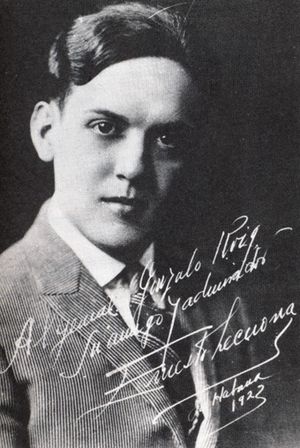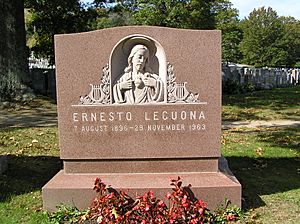Ernesto Lecuona facts for kids
Ernesto Lecuona y Casado (born August 7, 1896 – died November 29, 1963) was a famous Cuban composer and pianist. Many of his musical pieces are still very popular today. They are considered "standards" in Latin, jazz, and classical music. He wrote over 600 songs, including pieces for piano and large orchestras. He also wrote for a type of Spanish musical play called zarzuelas.
In the 1930s, Ernesto Lecuona helped start a popular band called the Lecuona Cuban Boys. This band played many of his most successful songs. Later, in the 1950s, he recorded several music albums. He moved to the United States after the Cuban Revolution. He passed away in Spain in 1963.
Contents
Ernesto Lecuona's Early Life
Ernesto Lecuona was born in Guanabacoa, Havana, Cuba. His mother was Cuban, and his father was from the Canary Islands. He began learning to play the piano when he was just five years old. His older sister, Ernestina Lecuona, who was also a well-known composer, taught him.
Ernesto was a child prodigy, meaning he was very talented at a young age. He wrote his first song when he was only 11 years old! He later studied at the Peyrellade Conservatoire. When he was 15, he graduated from the National Conservatory of Havana. He even won a Gold Medal for his amazing piano playing. In 1916, he performed outside of Cuba for the first time in New York.
In 1918, he worked with other musicians to create a factory in Cuba. This factory made music rolls for player pianos. They produced Cuban music and also copied music from the US.
How Ernesto Lecuona Became Famous
Ernesto Lecuona first traveled to Spain in 1924 for a concert tour. His piano concerts in Paris in 1927 and 1928 were very successful. This helped Cuban music become more popular around the world. His fame grew, and he performed in many cities. These included Buenos Aires, Rio de Janeiro, and Lima in South America. He also played in Paris, London, and New York.
His musical play, María la O, was first performed in Havana in 1930. Ernesto Lecuona wrote a lot of music for plays and movies. He created music for films like The Cuban Love Song and Always in My Heart. He wrote all the music for the movie Carnival in Costa Rica.
His works included zarzuelas, Afro-Cuban rhythms, and many famous songs. Some of his most well-known songs are "Siboney" and "Malagueña". In 1942, his song "Always in my Heart" was nominated for an Academy Award. This is a very big award for movies and music.
Ernesto Lecuona was also a master of symphonic music. He even conducted his own orchestra, the Ernesto Lecuona Symphonic Orchestra. This orchestra performed at Carnegie Hall in New York in 1943. That concert included the first-ever performance of his Black Rhapsody.
Ernesto Lecuona's Later Life and Impact
In 1960, Ernesto Lecuona moved to Tampa, Florida, in the United States. He was not happy with the new government in Cuba. He lived his last years in the US. However, he passed away in the Canary Islands on November 29, 1963. He was trying to recover from a lung problem there.
He is buried in Gate of Heaven Cemetery in Hawthorne, New York. His will states that he wants his remains to be returned to Cuba one day. A lot of Lecuona's music was first introduced to American audiences by Desi Arnaz. Desi Arnaz was also Cuban and was married to the famous actress Lucille Ball.
Ernesto Lecuona's amazing talent for writing music had a big impact on Latin America. He helped Cuban music become recognized as classical music. This is similar to how George Gershwin influenced music in the United States.
Ernesto and Ernestina's cousin, Margarita Lecuona, was also a talented musician. She wrote the song "Babalú". This song became very popular thanks to singers like Miguelito Valdés and Desi Arnaz.
Selected Compositions
For Piano
- Ante El Escorial
- Aragón
- Aragonesa
- San Francisco El Grande
- Siboney
- Suite Andalucía
- Córdoba
- Andalucía
- Alhambra
- Gitanerías
- Guadalquivir
- Malagueña
- Valencia Mora
- Zambra Gitana
Waltz
- Apasionado
- Crisantemo
- La bemol
- Maravilloso
- Poético
- Romántico
- Si menor (Rococó)
- Vals Azul
Other Works
- Afro-Cuban suite
- Ahí viene el chino
- Al fin te vi
- Amorosa
- Andar
- Aquí está
- Arabesque
- Bell Flower
- Benilde
- Burlesca
- Canto del guajiro
- Cajita de música
- Como arrullo de palmas
- Como baila el muñeco
- Dame tu amor
- Danza de los Ñáñigos
- Danza Lucumí
- Diario de un niño
- Ella y yo
- ¡Échate pa'llá María!
- El batey
- El miriñaque
- El sombrero de yarey
- El tanguito de Mamá (also called A la Antigua)
- En tres por cuatro
- Eres tú el amor
- Futurista
- Gonzalo, ¡no bailes más!
- Impromptu
- La 32
- La primera en la frente
- La Comparsa
- La conga de medianoche
- La habanera
- La danza interrumpida
- La mulata
- La negra Lucumí
- La Cardenense
- Los Minstrels
- Lola Cruz
- Lola está de fiesta
- Lloraba en sueños
- Mazurka en glissando
- Melancolía
- Mientras yo comía maullaba el gato
- Mis tristezas
- María la O
- Muneca de Cristal
- Muñequita
- Negra Mercé
- Negrita
- ¡No hables más!
- No me olvides
- No puedo contigo
- Noche Azul
- Orquídeas
- Pensaba en ti
- Polichinela
- ¿Por qué te vas?
- Preludio en la noche
- ¡Que risa me da! Mi abuela bailaba así
- Rapsodia Negra
- Rosa, la china
- Tú serás
- Tres miniaturas
- ¡Y la negra bailaba!
- ¡Y sigue la lloviznita!
- Yo soy así
- Yumurí
- Zapateo y guajira
- Zenaida
See also
 In Spanish: Ernesto Lecuona para niños
In Spanish: Ernesto Lecuona para niños
- List of Cubans
- Rafael Lecuona
- Marcos Madrigal




